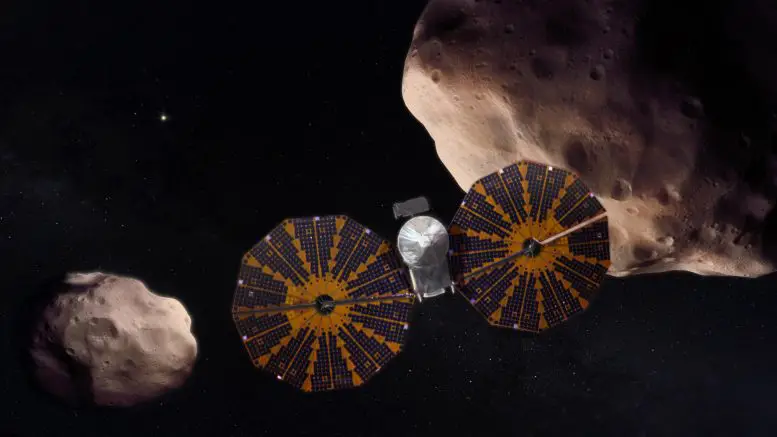Lucy will explore the Jupiter Trojan asteroids – thought to be “fossils of planet formation.” Credit: NASA’s Goddard Space Flight Center
NASA’s Lucy mission captured its first views of four Jupiter Trojan asteroids, with observations helping to choose exposure times for close-up observations. Lucy is on a 12-year voyage to observe nine Jupiter Trojans and two main belt asteroids, the first mission to ever visit them.
Some of the asteroids NASA’s Lucy mission will visit are still more than 330 million miles (530 million kilometers) away from the spacecraft, which is more than three times the average distance between Earth and the Sun. But despite the great distance and the comparatively small sizes of these asteroids, Lucy caught views of four of them recently.
From March 25 to 27, 2023, Lucy used its highest resolution imager, L’LORRI, to capture its first views of four Jupiter Trojan asteroids. From left to right: Eurybates, Polymele, Leucus, and Orus. Credit: NASA/Goddard/SwRI/JHU-APL
From March 25 to 27, 2023, Lucy used its highest resolution imager, L’LORRI, to capture its first views of four Jupiter Trojan asteroids. From left to right in the above image: Eurybates, Polymele, Leucus, and Orus.
Although the four images are all at the same scale, the orientation of each is different, reflecting the different orientations of the L’LORRI camera as it turned to capture each target.
The targets were also observed for different time periods based on their rotation periods:
Eurybates images were taken over a span of 6.5 hours.
Polymele, about 2.5 hours.
Leucus, 2 hours.
Orus, 10 hours.
These images are the first in a series of planned observations designed to measure how the Trojan asteroids reflect light at higher angles than is observable from Earth. Though the asteroids are still just single points of light in these images, seen against a background of distant stars, the data will help the team choose exposure times for Lucy’s close-up observations of its targets.
Lucy will fly by these asteroids in 2027 and 2028 as the spacecraft travels through a swarm of small asteroids that lead Jupiter in its orbit around the Sun. Lucy is just more than a year into a 12-year voyage that entails close observation of nine of Jupiter’s Trojans — the first space mission ever to visit them — and two main belt asteroids.
Source: scitechdaily










